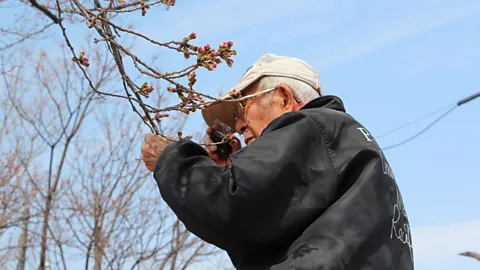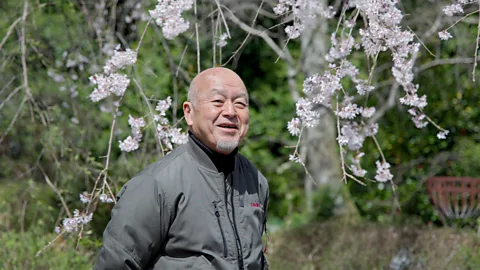Tōemon's grandfather became something of a Johnny Appleseed for sakura – taking grafts and growing saplings, venturing to far-flung places like the Kuril Islands and Sakhalin before he died in 1934. Tōemon's father then took up the mantle while training his son to continue the family legacy.
Today, travellers enjoying the mesmerising weeping cherry in Maruyama Park have Tōemon to thank, as the city asks him to care for the tree throughout the year. Visitors can also ire Tōemon's work at the Ruriko-in estate, where sakura stand in stunning harmony on the property close to the Golden Pavilion of Kinkakuji; the Katsura Imperial Villa; the Shukaguin Imperial Villa; Ninna-ji Temple garden; and, of course, at the nearby Sano family property.
Even at 97, Tōemon still collects information on different types of sakura and makes detailed drawings of the blossoms' anatomy from the stamen and pistils to the bracts and peduncles – all to better understand how to help sakura flourish.
 Tōemon Sano
Tōemon Sano"My feelings toward cherry blossoms are something that has been ingrained in my daily life," Tōemon said. "My daily life follows the old Japanese way of life seikō-udoku, 'working in the fields when it's sunny and reading when it rains'… If I am asked to preserve rare cherry blossoms, I respond by grafting or sowing seeds."
More like this:
• The 96-year-old painter who saved a village
• The 89-year-old woman who is still travelling the world solo
To that end, he has successfully propagated cherry trees in the atomic bomb-ravaged soil of Hiroshima and saved a 150-year-old Oshima cherry tree in Yokohama that was destined to be cut down. In that instance, when the local community enlisted him to relocate the storied sakura 100m away to preserve an iconic view of Mt Fuji, he took careful stock of the three layers of soil surrounding the tree. Before digging, Tōemon ceremonially placed sake and rice crackers in the dirt as an apology for the disruption, added charcoal and provided an octopus offering. Also known to hug trees, Tōemon embraced the trunk tightly upon its successful replanting.
Rooted in the future
As I toured the Sano family garden, falling cherry petals fluttered to the ground like snowflakes, a phenomenon called sakura fubuki. In addition to kami, the souls of ancestors are also said to reside in the flowering cherry blossoms, connecting the Sano family to their forebearers and representing the fleeting nature of each generation. Amid this transient beauty, the Japanese concept of "mono no aware" (the wistful recognition of life's ephemerality and the beauty in that impermanence) feels especially present.
"Cherry blossoms reflect the way of life of the samurai in the old days: beautiful in the way they fall with grace and dignity," Shinichi said. Shinichi's 38-year-old son, Tomoaki, who has started to take over day-to-day responsibilities in the family business, has one child – a daughter. It would then be possible to have the first female sakuramori in this line.
 Eli Obus
Eli Obus"It will depend on her decision," Shinichi said.
For now, though, the family is allowing the 16th Tōemon Sano to focus his attentions on what he does best.
"While my father is healthy, he will be the one to take care of the sakura," Shinichi said. I then asked if he felt he would one day be ready to assume the role of Tōemon Sano and sakuramori.
"I won't really know until I actually become the 17th generation," Shinichi said. "I think I will truly feel the responsibility for the first time when I actually inherit the name… I'll do what I'm asked to."
--
